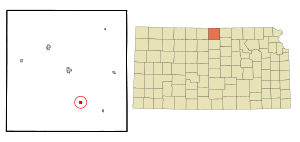Jewell, Kansas facts for kids
Quick facts for kids
Jewell, Kansas
|
|
|---|---|

Location within Jewell County and Kansas
|
|

|
|
| Country | United States |
| State | Kansas |
| County | Jewell |
| Founded | 1870 |
| Incorporated | 1880 |
| Named for | Lewis Jewell |
| Area | |
| • Total | 0.41 sq mi (1.06 km2) |
| • Land | 0.41 sq mi (1.06 km2) |
| • Water | 0.00 sq mi (0.00 km2) |
| Elevation | 1,555 ft (474 m) |
| Population
(2020)
|
|
| • Total | 370 |
| • Density | 902/sq mi (349/km2) |
| Time zone | UTC-6 (CST) |
| • Summer (DST) | UTC-5 (CDT) |
| ZIP code |
66949
|
| Area code | 785 |
| FIPS code | 20-35475 |
| GNIS ID | 2395470 |
Jewell is a small city in Jewell County, Kansas, United States. In 2020, about 370 people lived there.
Contents
History of Jewell
The city of Jewell started in 1870. It was first a large area surrounded by a sod wall, called Fort Jewell. It was named after Lieutenant-Colonel Lewis R. Jewell. He was a brave soldier who died in 1862 from injuries he got in a battle.
The first post office in Jewell opened in July 1870. This meant people could send and receive mail. Jewell officially became a city in 1880. It was also located along the Missouri Pacific Railroad, which helped it grow.
In 1999, a new community center was built. It's across from the city park. This center has a public library, offices for the American Legion, and even a small hotel with four rooms.
Geography of Jewell
Jewell is a small city in terms of size. According to the United States Census Bureau, the city covers about 0.43 square miles (1.11 square kilometers). All of this area is land, with no water.
People of Jewell
| Historical population | |||
|---|---|---|---|
| Census | Pop. | %± | |
| 1880 | 372 | — | |
| 1890 | 702 | 88.7% | |
| 1900 | 736 | 4.8% | |
| 1910 | 839 | 14.0% | |
| 1920 | 805 | −4.1% | |
| 1930 | 707 | −12.2% | |
| 1940 | 669 | −5.4% | |
| 1950 | 593 | −11.4% | |
| 1960 | 582 | −1.9% | |
| 1970 | 569 | −2.2% | |
| 1980 | 589 | 3.5% | |
| 1990 | 529 | −10.2% | |
| 2000 | 483 | −8.7% | |
| 2010 | 432 | −10.6% | |
| 2020 | 370 | −14.4% | |
| U.S. Decennial Census | |||
Jewell's Population in 2020
The 2020 United States census counted 370 people living in Jewell. There were 175 households, which are groups of people living together. Most people in Jewell are white. A small number of people are from other racial backgrounds.
About 16% of the households had children under 18. Many households were married couples. About 45% of households had only one person living there. The average age in Jewell was about 47.7 years old. This means many people living in Jewell are adults.
Jewell's Population in 2010
In the census of 2010, there were 432 people in Jewell. There were 208 households. Most people were White. Some people were Native American or from other backgrounds.
About 20% of households had children under 18. Many households were married couples. A lot of households (about 43%) had just one person living there. The average age was 49.2 years. About 26% of the people were 65 years old or older.
Education in Jewell
Students in Jewell go to schools in the Rock Hills USD 107 public school district. This district was created in 2006 when two smaller school districts joined together.
Before that, in the 1960s, the schools in Randall and Jewell combined to form Jewell-Randall schools. The high school mascot for Jewell High School was the Jewell Wildcats. The Wildcats won several state championships in track and field:
- 1967 Boys Track & Field - Class BB
- 1968 Boys Track & Field - Class BB
- 1991 Boys Track & Field - Class 1A
See also
 In Spanish: Jewell (Kansas) para niños
In Spanish: Jewell (Kansas) para niños

